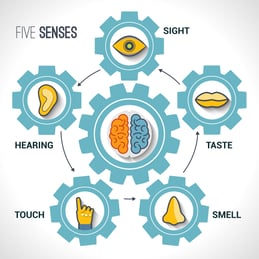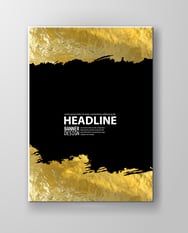Unlike one-dimensional digital ads, printed marketing materials connect with more of our senses. You can you see vividly printed pieces, but you can also touch, feel, and even smell them.
You can you see vividly printed pieces, but you can also touch, feel, and even smell them.
A printed piece appeals to us visually and makes us want to touch it. We become engaged at a deeper neurological level. This heightened response makes us more receptive to messages conveyed through print. Printers can intensify this haptic response with embellishments that add tactile appeal.
Printers have historically performed embossing, debossing, foiling, die cutting, spot varnishing, and raised UV in post-press production, often outsourcing the work. Today, printers can embellish documents in-house. Some techniques can even be performed inline on an offset or digital press.
Die cuts, varnishes or foils help people remember and recognize your customers’ brands. Embellishments heighten perceptions of value, status, and prestige. Tactile experiences increase retention and can improve response rates. Embellishments can also have measurable profit-driving results, generating a higher ROI on your customer’s marketing investments.
Embossing and Debossing
Embossing creates a raised pattern in the substrate with an embossing tool that presses a pattern or design into a page. Debossing depresses the image into a substrate, creating a concave impression. Some digital presses can now create this effect inline as part of the printing process, reducing time and costs.
 Foiling
Foiling
Foiling adds glossy or matte metallic finishes to a printed piece. Foil communicates higher value for the product, service, or company associated with the printed material. Hot foiling uses a metal die made in the pattern of the image to be foiled. A machine presses the foil against the substrate under intense pressure and high heat. The excess foil is then stripped away. Another foiling method, cold stamping, uses glue to adhere the foil to the desired areas.
Digital presses can replicate foiling with metallic ink, often as a fifth color. This gives printers an opportunity to apply a metallic look to variable data — something impossible to do with traditional hot or cold foiling methods.
Die Cutting

Die cutting is another embellishment technique improved with technology. In fact, die cuts no longer require a die! Digital die cutters use lasers to cut intricate patterns into substrates. Printers can economically add this haptic element to printed pieces, even on short-run jobs.
Coatings and Varnishes
Coatings can be applied to selected areas of a page. Printers can highlight a company logo, for instance, on a folder or report cover. The coating makes the logo reflect more light. Coated images stand out against a matte background.
UV curable coating fluids dry instantly under UV lamps, allowing printers to apply fluids in thicknesses that make the coated portions rise above the surrounding area. With this technique, printers can make memorable pieces for their customers, creating touchable effects such as fish scales, sand, or water drops.
Printers can create more tactile effects with coating techniques such as glitter, metallic sheen, or pearlescent coating.
Brands want their materials to stand out, get attention, and be recognized. Printers that can help them achieve those goals by exploiting the influence of touchable print. Special attention and creativity that gets results will forge strong relationships with your customers.
A version of this article was also published on ColorKarma.com under the title "Touchable Print."

